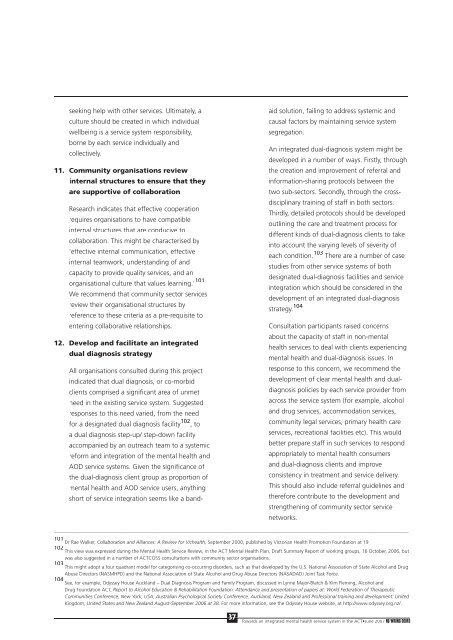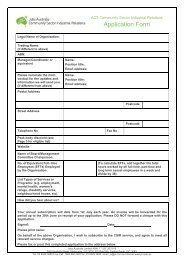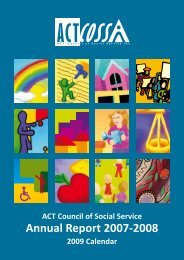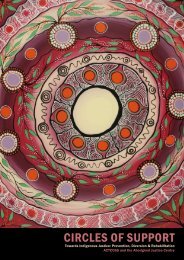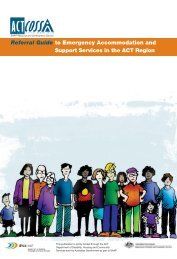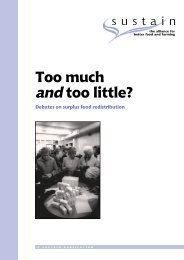actcoss text final.indd - ACT Council of Social Service
actcoss text final.indd - ACT Council of Social Service
actcoss text final.indd - ACT Council of Social Service
Create successful ePaper yourself
Turn your PDF publications into a flip-book with our unique Google optimized e-Paper software.
seeking help with other services. Ultimately, a<br />
culture should be created in which individual<br />
wellbeing is a service system responsibility,<br />
borne by each service individually and<br />
collectively.<br />
11. Community organisations review<br />
internal structures to ensure that they<br />
are supportive <strong>of</strong> collaboration<br />
Research indicates that effective cooperation<br />
requires organisations to have compatible<br />
internal structures that are conducive to<br />
collaboration. This might be characterised by<br />
‘effective internal communication, effective<br />
internal teamwork, understanding <strong>of</strong> and<br />
capacity to provide quality services, and an<br />
organisational culture that values learning.’ 101<br />
We recommend that community sector services<br />
review their organisational structures by<br />
reference to these criteria as a pre-requisite to<br />
entering collaborative relationships.<br />
12. Develop and facilitate an integrated<br />
dual diagnosis strategy<br />
All organisations consulted during this project<br />
indicated that dual diagnosis, or co-morbid<br />
clients comprised a significant area <strong>of</strong> unmet<br />
need in the existing service system. Suggested<br />
responses to this need varied, from the need<br />
for a designated dual diagnosis facility 102 , to<br />
a dual diagnosis step-up/ step-down facility<br />
accompanied by an outreach team to a systemic<br />
reform and integration <strong>of</strong> the mental health and<br />
AOD service systems. Given the significance <strong>of</strong><br />
the dual-diagnosis client group as proportion <strong>of</strong><br />
mental health and AOD service users, anything<br />
short <strong>of</strong> service integration seems like a bandaid<br />
solution, failing to address systemic and<br />
causal factors by maintaining service system<br />
segregation.<br />
An integrated dual-diagnosis system might be<br />
developed in a number <strong>of</strong> ways. Firstly, through<br />
the creation and improvement <strong>of</strong> referral and<br />
information-sharing protocols between the<br />
two sub-sectors. Secondly, through the crossdisciplinary<br />
training <strong>of</strong> staff in both sectors.<br />
Thirdly, detailed protocols should be developed<br />
outlining the care and treatment process for<br />
different kinds <strong>of</strong> dual-diagnosis clients to take<br />
into account the varying levels <strong>of</strong> severity <strong>of</strong><br />
each condition. 103 There are a number <strong>of</strong> case<br />
studies from other service systems <strong>of</strong> both<br />
designated dual-diagnosis facilities and service<br />
integration which should be considered in the<br />
development <strong>of</strong> an integrated dual-diagnosis<br />
strategy. 104<br />
Consultation participants raised concerns<br />
about the capacity <strong>of</strong> staff in non-mental<br />
health services to deal with clients experiencing<br />
mental health and dual-diagnosis issues. In<br />
response to this concern, we recommend the<br />
development <strong>of</strong> clear mental health and dualdiagnosis<br />
policies by each service provider from<br />
across the service system (for example, alcohol<br />
and drug services, accommodation services,<br />
community legal services, primary health care<br />
services, recreational facilities etc). This would<br />
better prepare staff in such services to respond<br />
appropriately to mental health consumers<br />
and dual-diagnosis clients and improve<br />
consistency in treatment and service delivery.<br />
This should also include referral guidelines and<br />
therefore contribute to the development and<br />
strengthening <strong>of</strong> community sector service<br />
networks.<br />
___________________________________________________________________________________________________________________________<br />
101 Dr Rae Walker, Collaboration and Alliances: A Review for Vichealth, September 2000, published by Victorian Health Promotion Foundation at 19.<br />
102 This view was expressed during the Mental Health <strong>Service</strong> Review, in the <strong>ACT</strong> Mental Health Plan, Draft Summary Report <strong>of</strong> working groups, 16 October, 2006, but<br />
was also suggested in a number <strong>of</strong> <strong>ACT</strong>COSS consultations with community sector organisations.<br />
103 This might adopt a four quadrant model for categorising co-occurring disorders, such as that developed by the U.S. National Association <strong>of</strong> State Alcohol and Drug<br />
Abuse Directors (NASMHPD) and the National Association <strong>of</strong> State Alcohol and Drug Abuse Directors (NASADAD) Joint Task Force.<br />
104 See, for example, Odyssey House Auckland – Dual Diagnosis Program and Family Program, discussed in Lynne Major-Blatch & Kim Fleming, Alcohol and<br />
Drug Foundation <strong>ACT</strong>, Report to Alcohol Education & Rehabilitation Foundation: Attendance and presentation <strong>of</strong> papers at: World Federation <strong>of</strong> Therapeutic<br />
Communities Conference, New York, USA; Australian Psychological Society Conference, Auckland, New Zealand and Pr<strong>of</strong>essional training and development: United<br />
Kingdom, United States and New Zealand August-September 2006 at 38. For more information, see the Odyssey House website, at http://www.odyssey.org.nz/.<br />
37 Towards an integrated mental health service system in the <strong>ACT</strong>•June 2007 NO WRONG DOORS


